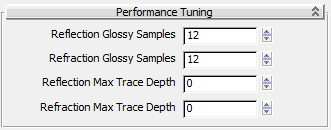The performance-tuning parameters let you tune performance by limiting the amount of calculation an Autodesk Material has to perform.
Note: Autodesk Materials do not appear in the Browser if the active renderer does not support them.
Interface
Note: There are four possible parameters, but for each material, only the relevant settings appear on the Performance Tuning rollout.

- Reflection Glossy Samples
- Defines the maximum number of samples (rays) that the renderer shoots to create glossy reflections. Higher values cause slow rendering but create a smoother result. Lower values render faster but create a grainier result. Generally 32 is enough for most cases. Default=8 for most Autodesk Materials, 0 for Mirror. Note: When Reflection Glossy Samples equals 0, the reflections take the form of a "perfect mirror" and only one ray is shot, regardless of the actual value of Glossiness . You can use this to boost performance for surfaces with very weak reflections.
- Refraction Glossy Samples
- Defines the maximum number of samples (rays) that the renderer shoots to create glossy refraction. Higher values cause slow rendering but create a smoother result. Lower values render faster but create a grainier result, like frosted glass. Generally 32 is enough for most cases. Range: Varies depending on the type of material. Default=8. Note: When Refraction Glossy Samples equals 0, the refraction takes the form of a "perfect lens" and only one ray is shot. You can use this to boost performance for draft renderings.
- Reflection Max Trace Depth
- When this trace depth is reached, the renderer stops calculating reflections. Range: Varies depending on the type of material. Default=0.
- Refraction Max Trace Depth
- When this trace depth is reached, the renderer stops calculating refractions. Range: Varies depending on the type of material. Default=0.